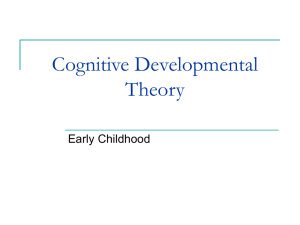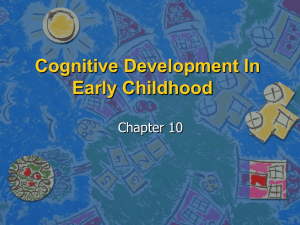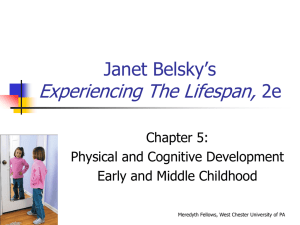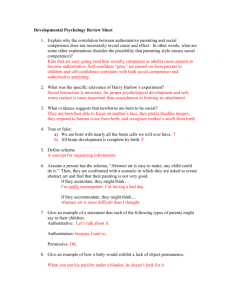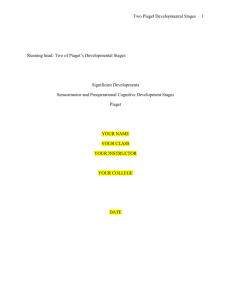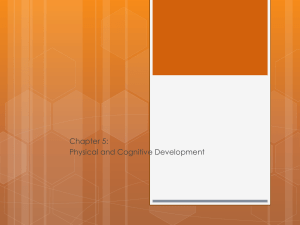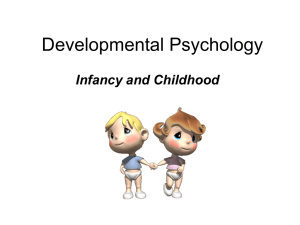Physical Development in Early Childhood
advertisement
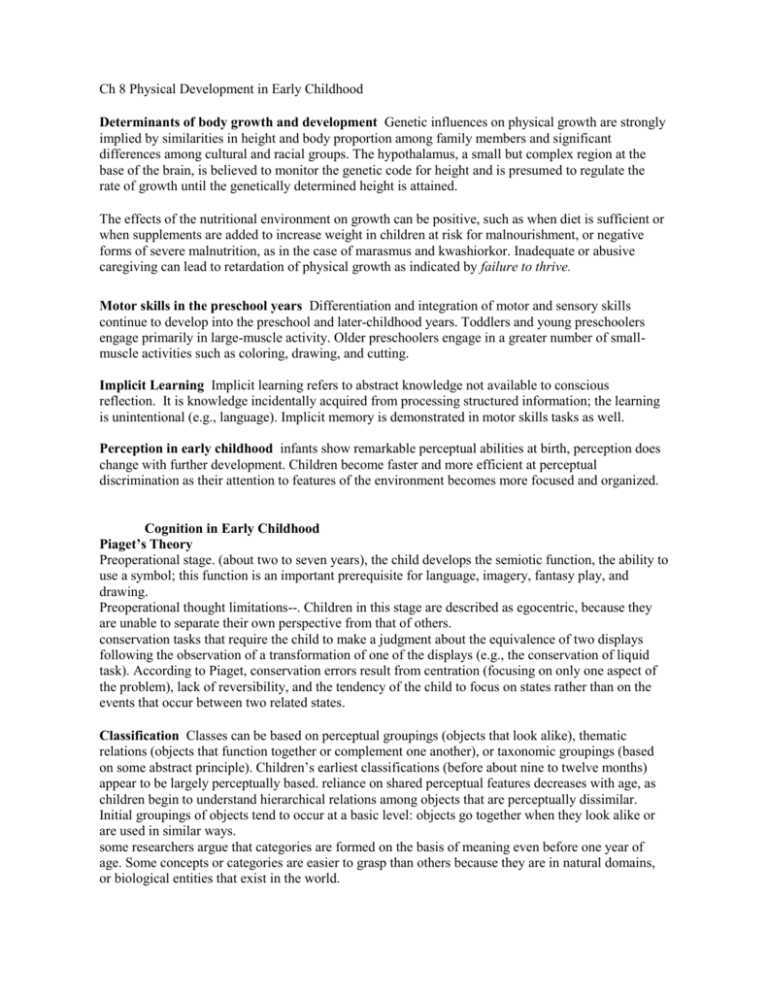
Ch 8 Physical Development in Early Childhood Determinants of body growth and development Genetic influences on physical growth are strongly implied by similarities in height and body proportion among family members and significant differences among cultural and racial groups. The hypothalamus, a small but complex region at the base of the brain, is believed to monitor the genetic code for height and is presumed to regulate the rate of growth until the genetically determined height is attained. The effects of the nutritional environment on growth can be positive, such as when diet is sufficient or when supplements are added to increase weight in children at risk for malnourishment, or negative forms of severe malnutrition, as in the case of marasmus and kwashiorkor. Inadequate or abusive caregiving can lead to retardation of physical growth as indicated by failure to thrive. Motor skills in the preschool years Differentiation and integration of motor and sensory skills continue to develop into the preschool and later-childhood years. Toddlers and young preschoolers engage primarily in large-muscle activity. Older preschoolers engage in a greater number of smallmuscle activities such as coloring, drawing, and cutting. Implicit Learning Implicit learning refers to abstract knowledge not available to conscious reflection. It is knowledge incidentally acquired from processing structured information; the learning is unintentional (e.g., language). Implicit memory is demonstrated in motor skills tasks as well. Perception in early childhood infants show remarkable perceptual abilities at birth, perception does change with further development. Children become faster and more efficient at perceptual discrimination as their attention to features of the environment becomes more focused and organized. Cognition in Early Childhood Piaget’s Theory Preoperational stage. (about two to seven years), the child develops the semiotic function, the ability to use a symbol; this function is an important prerequisite for language, imagery, fantasy play, and drawing. Preoperational thought limitations--. Children in this stage are described as egocentric, because they are unable to separate their own perspective from that of others. conservation tasks that require the child to make a judgment about the equivalence of two displays following the observation of a transformation of one of the displays (e.g., the conservation of liquid task). According to Piaget, conservation errors result from centration (focusing on only one aspect of the problem), lack of reversibility, and the tendency of the child to focus on states rather than on the events that occur between two related states. Classification Classes can be based on perceptual groupings (objects that look alike), thematic relations (objects that function together or complement one another), or taxonomic groupings (based on some abstract principle). Children’s earliest classifications (before about nine to twelve months) appear to be largely perceptually based. reliance on shared perceptual features decreases with age, as children begin to understand hierarchical relations among objects that are perceptually dissimilar. Initial groupings of objects tend to occur at a basic level: objects go together when they look alike or are used in similar ways. some researchers argue that categories are formed on the basis of meaning even before one year of age. Some concepts or categories are easier to grasp than others because they are in natural domains, or biological entities that exist in the world. Numerical concepts Piaget argued that preoperational children lack a full grasp of the meaning of number. According to Piaget, the preoperational child’s failure to conserve number results from the failure to understand the one-to-one correspondence that exists between the items of each row in the conservation task and from the failure to attain an understanding of cardinality and ordinality. Current research suggests that Piaget underestimated the preoperational child’s understanding of number concepts. Children as young as three and four years understand that number terms include quantitative relations (e.g., “smaller” and “larger”), and preoperational children understand the additive properties of numbers. Even newborns and very young infants may be able to detect differences between small numbers of objects, although whether this ability is on the basis of number or other criteria such as amount of contour is more difficult to determine. Spatial concepts Children organize information in terms of their location in physical space. Children initially locate objects by relying on the positions of their own bodies, particularly if no external environmental cues are available. When landmarks, or distinct cues, are available, preschool-age children make sufficient use of them to locate objects in large spatial environments. Young children also use geometric cues, such as the space of a room, to orient themselves in space. Map reading is a practical way in which spatial skills are exercised. Making use of a map involves several types of skills: understanding that symbols on the page refer to real objects or places, appreciating scale and alignment, and planning an efficient route. Improvements in children’s abilities to reason about relations among objects are a likely source of better map-reading skills. Understanding psychological states Thinking about the self and its relationship to the social world is called social cognition and is a vital aspect of successful communication and social interaction. An important ability necessary for understanding and interacting with others is perspective taking, the ability to put oneself in another person’s place. Piaget and Inhelder described four-to-six-year-olds as displaying considerable egocentrism when evaluating the visual perspectives of others. recent research suggests that children as young as three to four years can identify the perspectives of others reasonably well. John Flavell distinguishes between two levels of visual perspective-taking skill. At the first level (late infancy to about three years), children realize that their views do not always match others’ views. At the second level (age three years and onward), children become increasingly proficient at determining the specific limitations of others’ views. As children develop cognitively, they gain an increasingly coherent appreciation of the mental states of themselves and others. Recent research suggests that by the time they enter school, children have a well-developed “theory of mind.” Using a “false belief” task, researchers have shown that four-yearolds are aware of the content of another person’s beliefs. Research with children from several cultures has shown similar developmental changes in their understanding of “beliefs,” suggesting that a theory of mind may have a biological basis. On the other hand, the influence of socialization experiences is suggested by findings that family size, conversational experiences, and language capabilities are among a number of factors related to success on false-belief tasks. Atypical Development: Childhood Autism Numerous theories have been advanced to explain the causes of autism, a severe psychological disorder that affects about one or two out of every thousand children born. A recent suggestion is that autistic children fail to develop a “theory of mind.” As a result of this possible lack of knowledge of the mental states of others, autistic children may suffer from severe deficits in communication and social interaction. Memory The ability to remember is critical for performing cognitive activities. Thus, memory has been an important area of developmental research and has been conceptualized in many different ways. Episodic memory is memory for events that took place at a specific time and place. Semantic memory is memory for facts and general concepts not related to any specific event. Scripts are organized schemes of knowledge about commonly encountered events. By the age of three or four, most children have a general schematic representation for the events that occur at dinner time, for example. The use of scripts allows children to remember more details associated with the scripted activity. These general frameworks allow for storage of specific memories and may be one of the earliest building blocks for memory. Most individuals are unable to recall experiences prior to about three years of age, a phenomenon called infantile amnesia. By about three years of age, however, children begin to display autobiographical memories--- can recall fairly lengthy and cohesive descriptions of the events they have experienced. Explanations for infantile amnesia include the inability to code information verbally, lack of understanding of self, difficulty in understanding the structure of narrative recall, and absence of a theory of mind at younger ages. Controversy: How Reliable is Children’s Eyewitness Testimony? Although research has demonstrated that children have impressive memories, some have questioned the accuracy of their memories when children are called on to testify in the courts. Some studies indicate that young children are more likely than older children to distort their recollections of events as a result of leading questions, although other studies have failed to find age differences in susceptibility to leading questions. Several factors may influence children’s susceptibility to misleading information, including the perceived power of the person providing the misinformation and the emotionally charged environment of the courtroom. Memory also clearly declines over the passage of time. Problem solving skills An essential requirement in problem solving is the ability to use symbols to represent real objects. Although infants may be able to represent other objects via symbols, even preschoolers show limitations in this capacity. between two and three years of age, children have to overcome difficulties with dual representations, that is, the ability to understand that an object can be represented and, at the same time, can represent something else. child then displays representational insight. Planning is key aspect of problem solving. As children become older, their ability to create plans improves and their plans become more flexible. Parental and instructional guidance and an increasing orientation toward the future impacts child’s abilities to anticipate and modify familiar routines. With development, children also become more likely to choose from among several strategies for solving a problem rather than relying on one. Children not only resort to multiple strategies in their efforts to solve problems, but also blend strategies together. In doing so, they also become more proficient at using those strategies which are most appropriate for the problem at hand. important to transfer or generalize successful problem-solving skills to new situations. In analogical transfer, elements of one problem are successfully applied to solve a problem in a different domain. Research indicates that toddlers, and possibly even infants, are capable of displaying analogical transfer. Language in Early Childhood The effective use of language includes nonverbal behaviors, rules of etiquette, and even changing the content of speech based on the identity of the listener and the context. Semantics Children derive the meanings of words in a variety of ways. Several researchers suggest that children are biased to form restricted hypotheses about the meanings of words. Constraints on word learning give children an edge in deciphering word meaning. The child also plays an active role by using context to provide clues to the meaning of an unfamiliar spoken word (a process called fastmapping) and is predisposed to the mutual exclusivity bias, the tendency to treat unfamiliar words as labels for new objects in the child’s immediate environment rather than as synonyms for words she or he already knows. Shape bias refers to children’s general assumption that a word applies to the whole object and particularly the shape of the object. Constraints on word learning may arise from growth in general knowledge about objects and relationships. It may also be that some word-learning biases are more important in the early stages while others play a larger role in later stages. Grammar grammar-- the rules pertaining to the structure of language. Grammar contains two components, syntax and morphology. Syntax refers to the rules of how words can be combined. Morphology refers to the rules for combining phonemes to form words. Two-word utterances begin at about 24 months; shortly after the child combines more than two words to express relations among objects and events. The child’s grammar during two-word stage--telegraphic speech, consisting of combinations of nouns, verbs, and adjectives without modifiers. two-word utterances are highly ordered (“more milk, more cookie”), often containing a pivot word (more) that is used as an anchor for open words (milk, cookie). The order also often reflects knowledge of semantic relationships. Later, children begin to fill in utterances with adjectives, pronouns, and prepositions and include inflections to signal plurals and verb tense. During this stage, children exhibit predictable changes in the use of negatives and in forming questions. Sometimes grammatical rules are overregularized, that is, extended to words that require exceptions to the rules. According to the semantic bootstrapping hypothesis, when children learn that a certain animal is a dog, they also notice that it is a thing (noun), and later on, that it is an agent (subject) or recipient (object) of action. Children’s knowledge of semantics influences their mastery of grammar. Pragmatics as preschoolers, children have some understanding of the pragmatics of language. Parents play an important role in teaching their children pragmatics, the proper use of speech in a social context, by giving direct instructions (“Say thank you”) and acting as models of politeness. Studies using referential communication tasks show that young children are limited in their ability to describe novel objects to other people. However, preschool children do adjust their speech to a simpler form when speaking to a younger child. The linguistic perspective Linguist theorists emphasize the child’s abstraction of general grammatical principles from the stream of speech. Noam Chomsky proposed that language is generative and that the child is biologically prepared to extract grammatical rules from language. Evidence in support of the linguistic perspective includes the very rapid acquisition of words and syntactic rules during the first five years, the application of those rules to new words never seen before, and the overuse of such rules, as in overregularizations. Efforts to teach language to members of the ape family have met with some limited success. Data showing that children creolized language and that animals are limited in their ability to learn language are consistent with linguistic theory, but some aspects of children’s verb learning are not.

